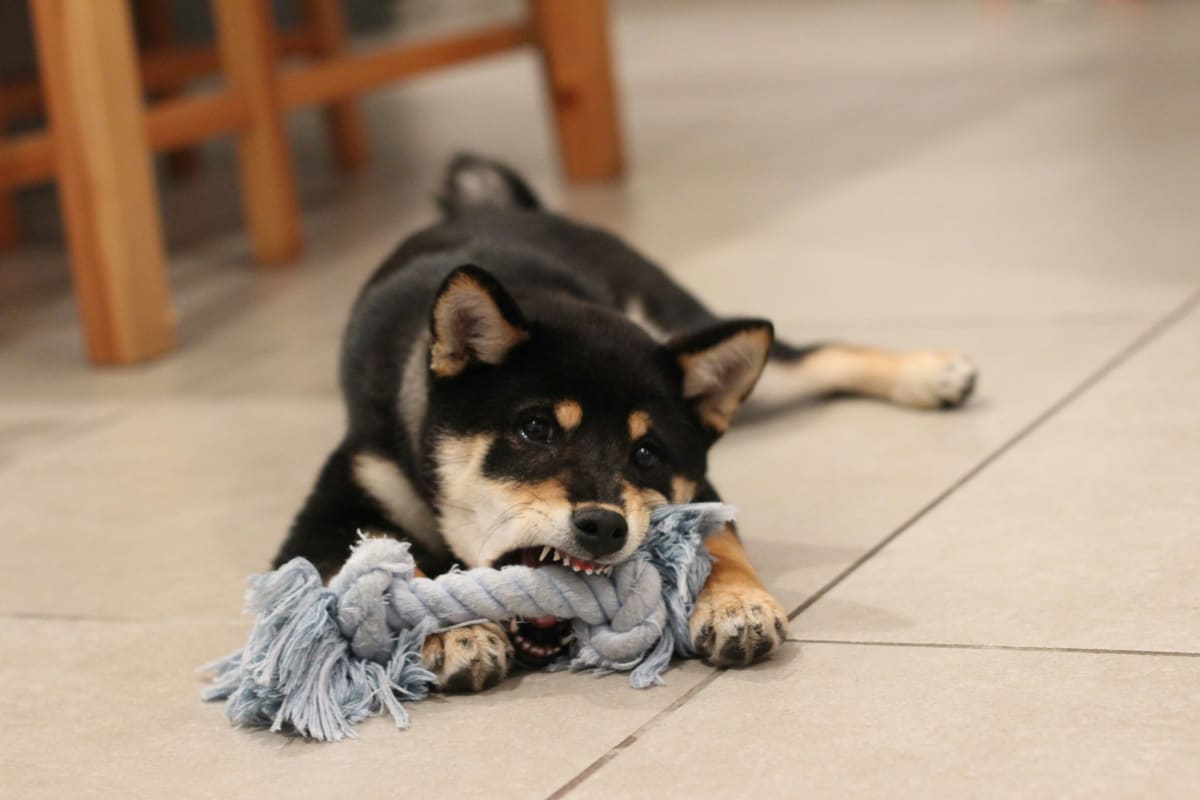Puppies have sharp milk teeth used to explore the world. Teeth are survival tools that allow them to eat food, chew, and defend themselves. Teeth are also social and communication tools used to get attention, wrestle, and play.
All puppies regardless of whether they are brachycephalic, mesaticephalic, or dolichocephalic are born with teeth buried below the gum line. By the three-week mark, most pups begin to develop some of their 28 deciduous teeth. The squishy-faced French Bulldog, medium snoot Cocker Spaniel, and long-nosed Dachshund will all develop 42 adult teeth. By the time the puppies are eight months old, they’ll develop 10 molars, 16 premolars, two canines, six incisors, and eight premolars that fit in different head shapes. These adult teeth won’t regrow if they’re lost and it’s rare to see them get cavities. However, you may find that short-snouted dogs are more prone to dental calculus, plaque, and tartar buildup than others.
When Do Puppies Lose Their Teeth?
 Teething happens gradually and causes a bit of pain. Puppies will drool, chew, have swollen gums, and a poor appetite as their first set of teeth push through the gum line. This happens when the puppies are around two to four weeks old.
Teething happens gradually and causes a bit of pain. Puppies will drool, chew, have swollen gums, and a poor appetite as their first set of teeth push through the gum line. This happens when the puppies are around two to four weeks old.
By the time your puppy is five to six weeks old, he should have developed 28 milk teeth. The incisors will appear first followed by canines and premolars.
Around four to six months old you’ll notice your pup’s appetite may diminish and you may find tiny rice-sized teeth on the floor. The puppy’s deciduous teeth are falling out and their adult teeth are erupting. The incisors will fall out first followed by premolars and canines. You may notice for a short time that your puppy appears to have double teeth. This happens when the puppy teeth haven’t fallen out, but the adult teeth have pushed through the gum line.
By six months old, he should have a mouthful of adult teeth that are sturdier and less sharp than the milk teeth. These new teeth are used to chew, grind food, and tear. They’re also used for defense and attack purposes.
If you notice any baby teeth remaining after six months, contact your local veterinarian.
How to Cope with Teething
Puppies chew to ease the pain of teething. Give your puppy chew toys, cold chews, ice cubes, or frozen chicken and beef broth to help with the discomfort of the teething process. Puppies will seek out anything to chew including wires, shoes, socks, and couches.
How to Stop a Puppy from Biting
Puppy nipping can be frustrating but it’s normal. When puppies are in a pack they’ll grab, move, and hold littermates with their sharp teeth. During this time, they’re learning bite inhibition. It’s natural. Just because the puppy is removed from his pack doesn’t mean his instinct to nip is quelled. He still must learn bite inhibition.
Puppies naturally bite one another. When they nip too hard, a puppy yelps, snaps at the biter, or stops playing. It is a natural consequence and the puppy that bit realizes he can’t mouth his littermate that hard.

Many puppies come home to their new families between eight to 12 weeks, so the puppy will learn bite inhibition on you instead of his littermates.
Puppies learn to bite softly from trial and error. They may roll around, have rough-and-tumble play, and nip you. It feels like a hard pinch.
Teach your puppy bite inhibition by letting him nibble on your arms or fingers. As soon as it hurts make a squeal or high-pitched yip. Then go back to playing with him. It will take a few months but over time even if the puppy’s nip is gentle, continue to react. It will teach him that he needs to reduce the pressure of his bite.
When the puppy nips at you over time, redirect him to play with a toy that he finds stimulating. He may like toys with treats, rubber chew toys, or balls and ropes.
You can also walk away so the puppy knows his bite hurt. This will help reduce the frequency of the biting.
To keep a puppy from continuing to nip, avoid rough play. Don’t let your puppy bite at your hair, skin, or clothes. If he does so, you can put the puppy in time out or walk away so he knows the behavior isn’t okay.
